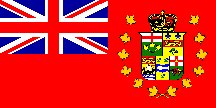Canadian Government and "UnOfficial" Flags
 |
|
 |
| British Red Ensign 1801 |
|
Canadian Red Ensign 1870 |
To understand the concept of "Official" and "UnOfficial" flags one must first understand the duality of Canadian government. To the American way of thinking, Canada would appear to have two governments at the same time. One government is the Royal government and one government is the government of the people ruled by an elected Parliament. To the Canadian way of thinking, Elizabeth II of the United Kingdom, is also the Queen of Canada, and is considered the sovereign head of state of Canada, but she gives her executive power, judicial and legislative power to the Dominion government and Parliament of Canada to rule for her. The Parliament is elected by the people of Canada, and chooses a Prime Minister as administrator of Canada. Sharing power with the Prime Minister and the Parliament is the Royal government, including a Royal viceroy called the Governor-General, who is appointed by the Queen. However, while the Queen appoints the Governor General in her capacity as Queen of Canada, the person to be appointed is nominated by the Parliament of Canada. The actual British government does not play any part in the process, only the Queen.
Many Americans don’t realize that the Governor-General (GG) is the Canadian head of state (as the Queen's deputy) and that the Prime Minister (PM) is head of government. The American President combines the role of the Prime Minister and the Governor-General into one person. It is interesting to note that President Franklin Roosevelt once told Prime Minister Mackenzie King that he considered Canada to be a republic masquerading as a monarchy in that actual head of state was elected by Parliament.
In practice, the sovereign or viceroy rarely intervene directly in political affairs, because Canada is a constitutional monarchy, and although the monarch does retain all power, it must be used with discretion, lest its use cause a constitutional crisis.
Because of all this, important Canadian national symbols like flags have to be approved by the Crown to be considered "Official." Tradition dictates that the British Admiralty approve all flags used by British subjects and British ships. Therefore, the various "UnOfficial" ensigns were unofficial only in so far as they were not recognized by the Admiralty, which regulates the flags to be used to identify ships at sea. The Dominion government and population used them on land as a matter of course.
In the late 19th Century Sir Joseph Pope, the Deputy Minister of External Affairs (it should probably be explained that the Deputy Minister is a civil servant, the permanent head of a Department, and a Minister is his or her political master who is appointed by the Prime Minister) set out to have all the provincial coats of arms and an official coat of arms for the Dominion established by the College of Heralds in London.
The process is a slow one that many Canadian flag makers and the general public sometimes didn't wait for, hence the "UnOfficial" versions of the flags, particularly among the Canadian Red Ensigns. Many times the problem, if it can be called a problem, lied with the College of Heralds, an ancient organization in England that keeps track and approves coats of arms (Shields) for the whole British Commonwealth. Their main concern was to make sure each design was original and met certain criteria. Until they approved a design, it just wasn't considered official.
To further muddy the process, the British Admiralty Council is an old and very tradition body of men, and they tend to change slowly and carefully as one would expect. Anyway, the combination of popular Canadian wishes and tradition at times collided, and hence during the 19th Century we had a series of popular versions of the Red Ensigns that differed on land and at sea, some considered "Official" and some considered "UnOfficial."
Until 1988, the College of Arms in London was the legal authority governing heraldry in Canada, as it is an office of the Royal Household rather than an office of the British government. In that year the Canadian Heraldic Authority was established as part of the Governor General’s household to deal with heraldry, seals, decorations (medals) and the like, all of which are granted as part of the Royal prerogative.
|